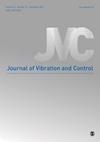Passive structural control for wind turbine towers using a novel dual-track nonlinear energy sink
IF 2.4
3区 工程技术
Q2 ACOUSTICS
引用次数: 0
Abstract
With larger rotors and taller towers developed to capture more wind energy, the tower structures become slenderer and more sensitive to wind loads, resulting in vortex-induced vibration (VIV) in both downwind and crosswind directions. The vibration control is faced with the challenges of broadband and multi-directional dynamic responses. Thus, this paper proposed a new type of dual-track nonlinear energy sink (NES) aimed to achieve the multi-mode and multi-direction vibration control of wind turbine towers. The two-degree-freedom coupled governing equations of the wind turbine tower with the dual-track NES are established and solved numerically, with full considerations of aerodynamics and fluid–solid interactions. Then, an optimized design of the dual-track NES is performed theoretically. To evaluate the vibration mitigation performance of the dual-track NES, a series of wind tunnel tests are carried out and analyzed further, in terms of the acceleration time-history response, statistical characteristics, frequency and damping ratio. It is demonstrated that the proposed NES functioning as an energy-dissipating device is efficient and robust in mitigating the dynamic response of wind turbine towers, even enabled to address the vortex resonance. It is remarkable that the dual-track NES can synchronously realize the vibration control in multi-mode and multi-direction by increasing the damping ratio of primary structure.利用新型双轨非线性能量汇实现风力涡轮机塔架的被动结构控制
随着为获取更多风能而开发的更大转子和更高塔架的出现,塔架结构变得更加纤细,对风载荷也更加敏感,从而导致顺风和横风方向的涡流诱导振动(VIV)。振动控制面临着宽带和多方向动态响应的挑战。因此,本文提出了一种新型双轨非线性能量汇(NES),旨在实现风机塔架的多模式和多方向振动控制。本文在充分考虑空气动力学和流固耦合作用的基础上,建立并数值求解了带有双轨非线性能量沉降器的风力发电机塔架的二自由度耦合控制方程。然后,从理论上对双轨 NES 进行了优化设计。为了评估双轨 NES 的减振性能,进行了一系列风洞试验,并从加速度时序响应、统计特性、频率和阻尼比等方面进行了进一步分析。试验结果表明,所提出的 NES 作为一种能量消耗装置,能够高效、稳健地减缓风力涡轮机塔架的动态响应,甚至能够解决涡流共振问题。值得注意的是,双轨 NES 可通过提高主结构的阻尼比,同步实现多模式、多方向的振动控制。
本文章由计算机程序翻译,如有差异,请以英文原文为准。
求助全文
约1分钟内获得全文
求助全文
来源期刊

Journal of Vibration and Control
工程技术-工程:机械
CiteScore
5.20
自引率
17.90%
发文量
336
审稿时长
6 months
期刊介绍:
The Journal of Vibration and Control is a peer-reviewed journal of analytical, computational and experimental studies of vibration phenomena and their control. The scope encompasses all linear and nonlinear vibration phenomena and covers topics such as: vibration and control of structures and machinery, signal analysis, aeroelasticity, neural networks, structural control and acoustics, noise and noise control, waves in solids and fluids and shock waves.
 求助内容:
求助内容: 应助结果提醒方式:
应助结果提醒方式:


